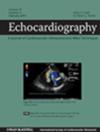Evaluation of right ventricular function in patients with Behcet's disease by four-dimensional echocardiography
Abstract
Aim
Behcet's disease (BD) is a systemic disorder characterized by vasculitis, resulting in thickened vascular walls that reduce elasticity and impair function. BD can involve the cardiovascular system in three ways: cardiac, arterial, and venous. In this study, our objective was to evaluate the efficacy of pulmonary arterial stiffness (PAS) and pulmonary pulse transit time (PPTT) measures in demonstrating right ventricular functions in asymptomatic BD patients. We aimed to objectively evaluate right ventricular function in patients with BD using four-dimensional echocardiography (4DE).
Method
This study included 40 patients diagnosed with BD and 40 healthy subjects. Demographic, clinical, laboratory, and echocardiographic parameters were compared. In addition to standard transthoracic echocardiographic evaluation, right ventricle quantification (RVQ) by using the 4DE and 2D-speckle tracking echocardiography were performed.
Results
The sPAP, 4D RVQ, and right ventricular strain values exhibited significant differences between the BD and control groups. Right ventricular end-diastolic diameter (RVDD), right ventricular end-systolic diameter (RVSD), right atrium (RA) area, right ventricular myocardial performance index (RVMPI), and PAS were increased in BD patients compared to the control group. Right ventricular ejection fraction (RVEF), right ventricular fractional area change (RVFAC), tricuspid annular plane systolic excursion (TAPSE), Tricuspid S’, and PPTT were decreased in BD patients compared to control subjects. PPTT correlated with right ventricular free wall strain (RV-FWS) and PAS. In a multivariate linear regression analysis, PAS and RVFAC were found to be independent predictors of RVFWS. In addition, RVFAC and TAPSE are independent predictors for PPTT.
Conclusion
Patients with BD may have elevated pulmonary arterial stiffness (PAS) in correlation with decreased PPTT. To ascertain the prognosis for these individuals, right ventricular (RV) functions must be evaluated. Measurements of RVFAC and RVEF via 4DE and deformation imaging techniques may be more useful in identifying subclinical impairment of RV. Individuals with BD, PAS, and PPTT may suggest a link between early pulmonary vascular remodeling and RV subclinical impairment.

 求助内容:
求助内容: 应助结果提醒方式:
应助结果提醒方式:


